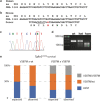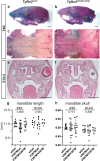This is a preprint.
Genetic Analysis and Functional Assessment of a TGFBR2 Variant in Micrognathia and Cleft Palate
- PMID: 38645005
- PMCID: PMC11030355
- DOI: 10.1101/2024.04.08.588524
Genetic Analysis and Functional Assessment of a TGFBR2 Variant in Micrognathia and Cleft Palate
Update in
-
Genetic analysis and functional assessment of a TGFBR2 variant in micrognathia and cleft palate.PLoS One. 2025 Jun 9;20(6):e0324803. doi: 10.1371/journal.pone.0324803. eCollection 2025. PLoS One. 2025. PMID: 40489498 Free PMC article.
Abstract
Cleft lip and cleft palate are among the most common congenital anomalies and are the result of incomplete fusion of embryonic craniofacial processes or palatal shelves, respectively. We know that genetics play a large role in these anomalies but the list of known causal genes is far from complete. As part of a larger sequencing effort of patients with micrognathia and cleft palate we identified a candidate variant in transforming growth factor beta receptor 2 (TGFBR2) which is rare, changing a highly conserved amino acid, and predicted to be pathogenic by a number of metrics. The family history and population genetics would suggest this specific variant would be incompletely penetrant, but this gene has been convincingly implicated in craniofacial development. In order to test the hypothesis this might be a causal variant, we used genome editing to create the orthologous variant in a new mouse model. Surprisingly, Tgfbr2 V387M mice did not exhibit craniofacial anomalies or have reduced survival suggesting this is, in fact, not a causal variant for cleft palate/ micrognathia. The discrepancy between in silico predictions and mouse phenotypes highlights the complexity of translating human genetic findings to mouse models. We expect these findings will aid in interpretation of future variants seen in TGFBR2 from ongoing sequencing of patients with congenital craniofacial anomalies.
Keywords: CRISPR; Cleft palate; Micrognathia; Pierre-Robin Sequence; TGFBR2.
Figures



References
-
- Behringer R. (2014). Manipulating the mouse embryo : a laboratory manual, Fourth edition. edn (Cold Spring Harbor, New York: Cold Spring Harbor Laboratory Press; ).
-
- Chai Y., Ito Y., and Han J. (2003). TGF-beta signaling and its functional significance in regulating the fate of cranial neural crest cells. Crit Rev Oral Biol Med 14, 78–88. - PubMed
Publication types
Grants and funding
LinkOut - more resources
Full Text Sources
Molecular Biology Databases
Research Materials
